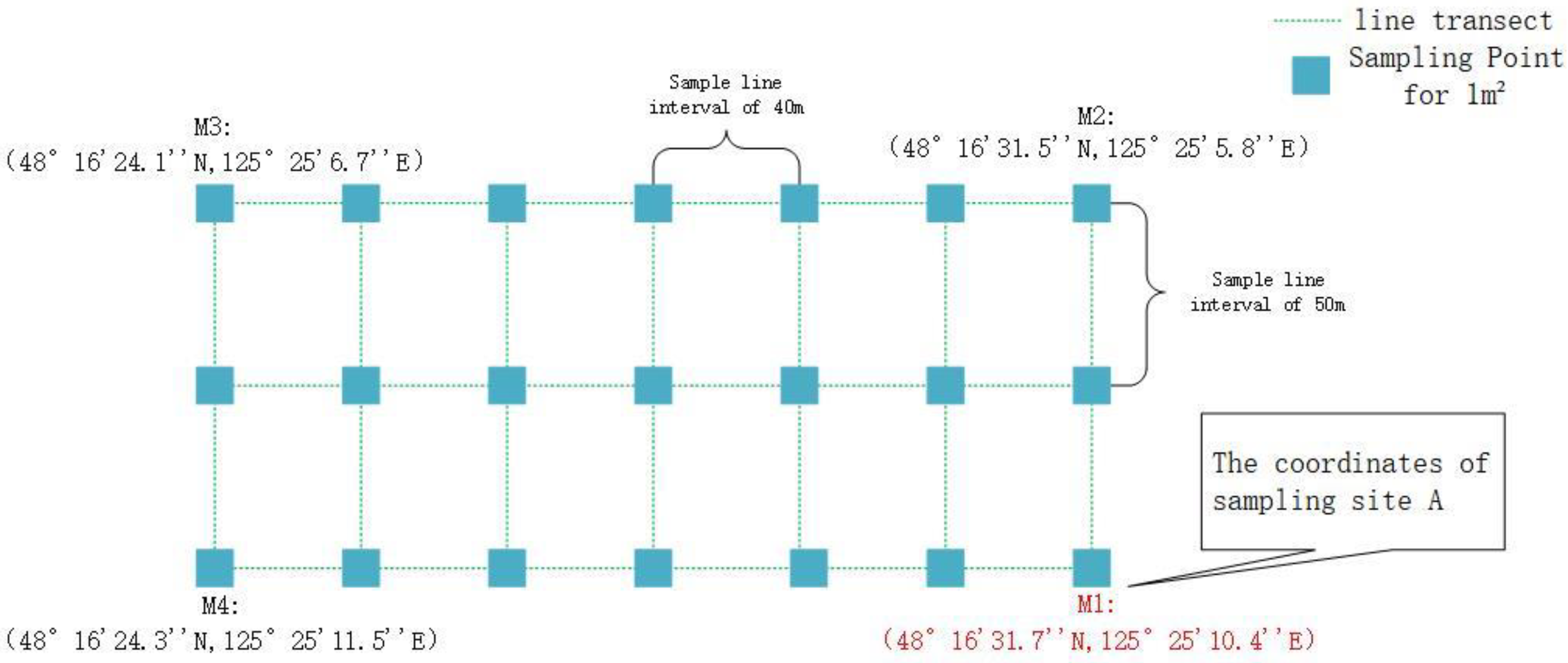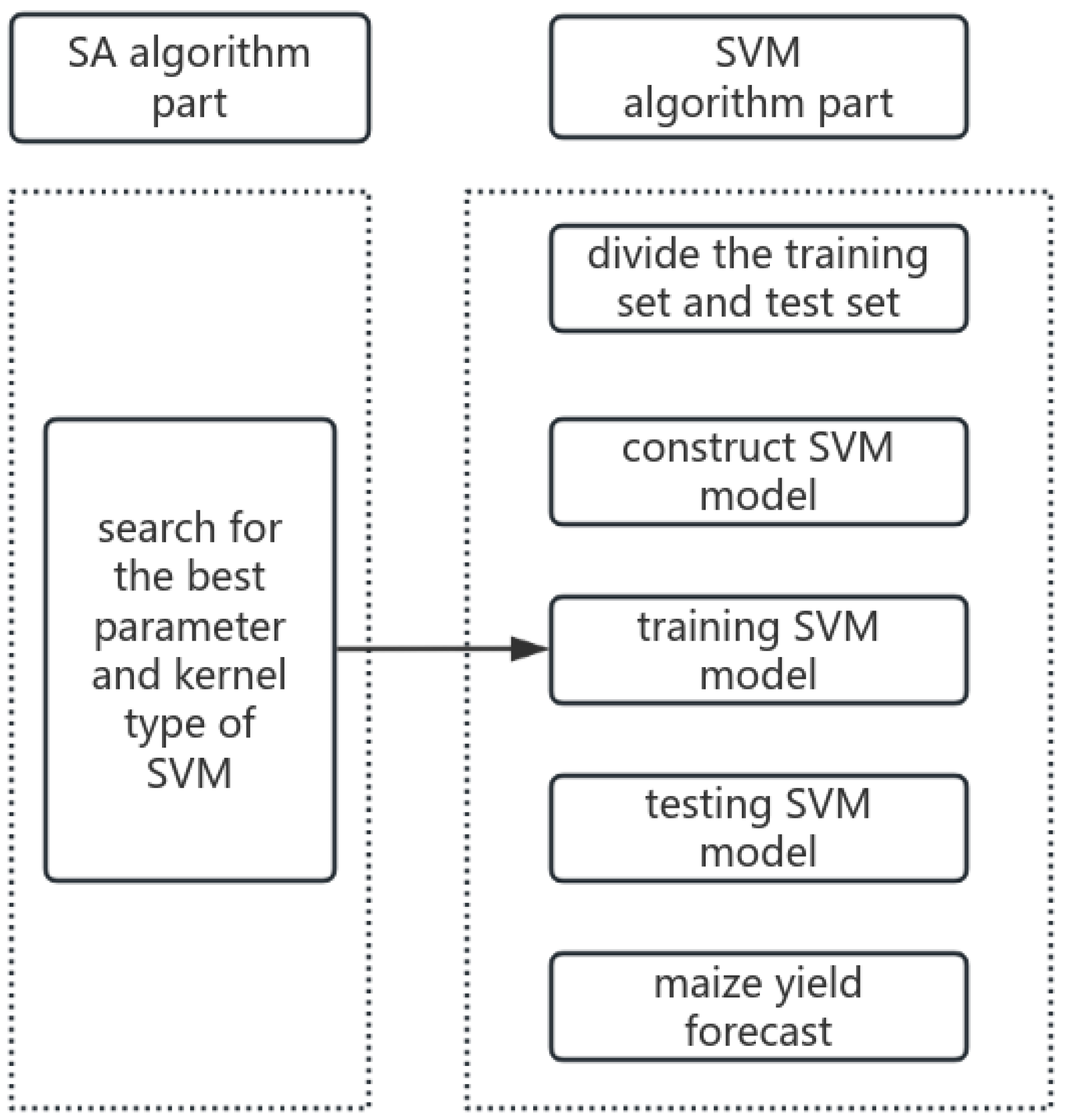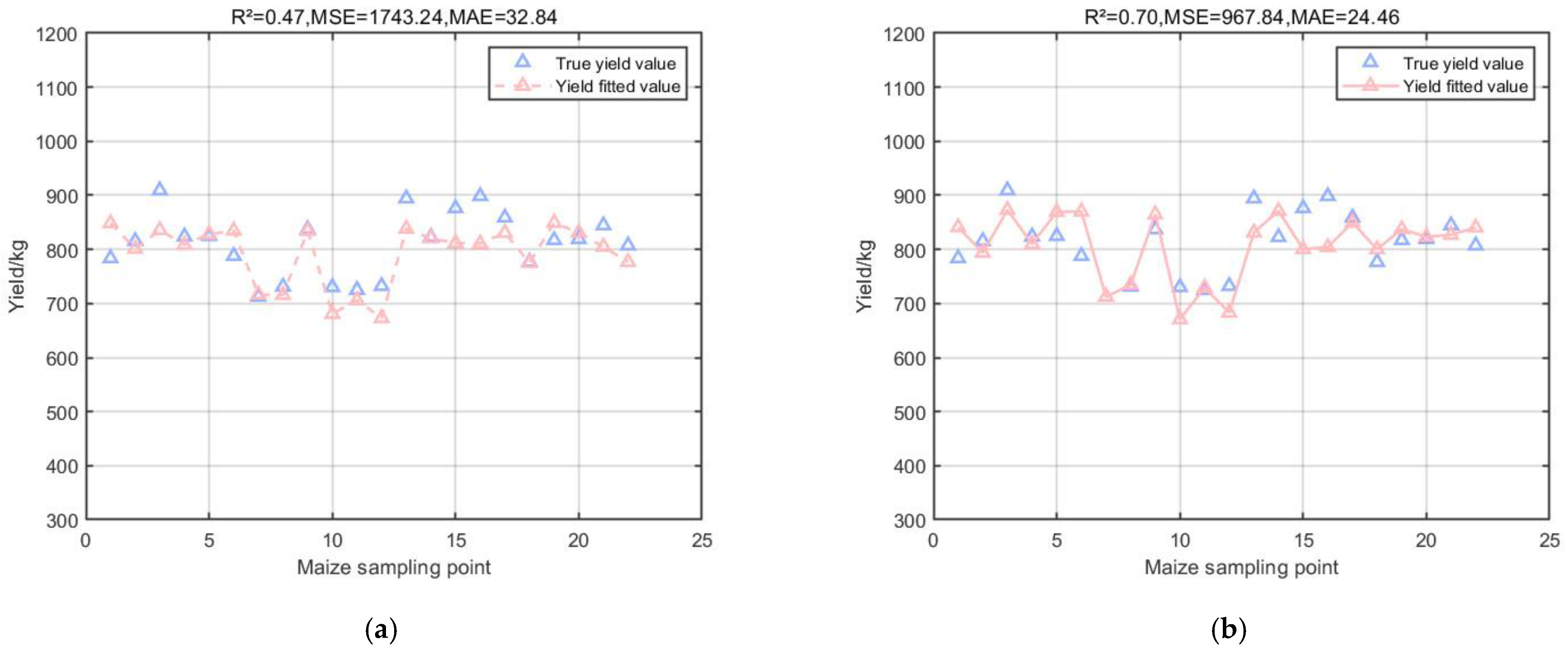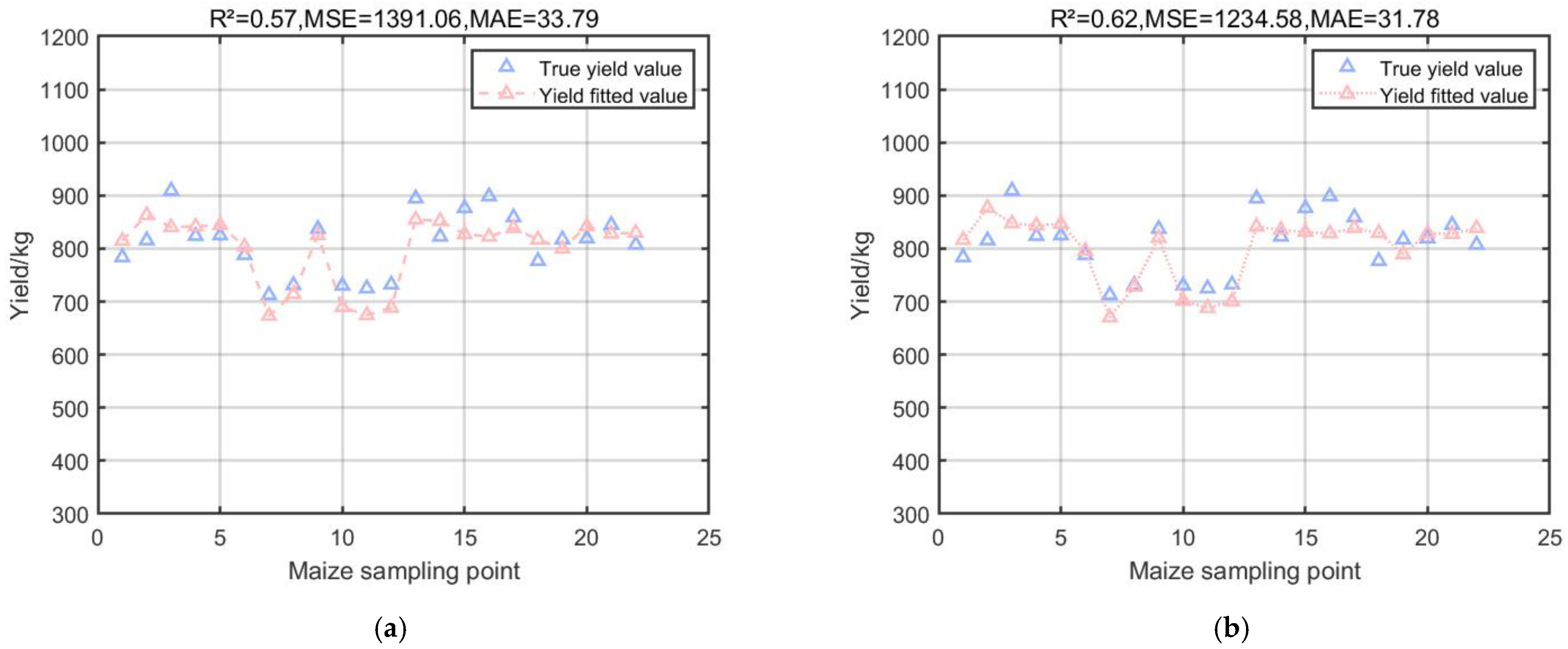Research on Evaluation Methods of Black Soil Farmland Productivity Based on Field Block Scale
Abstract
1. Introduction
2. Materials and Methods
2.1. Data Sources and Data Preprocessing
2.1.1. Description of the Experimental Site
2.1.2. Measurement of Physical and Chemical Properties of Soil
2.1.3. Data Preprocessing
2.2. Topsoil Productivity Evaluation Model
2.2.1. CI Model and Its Revisions
2.2.2. PI Model and Its Revisions
2.3. Machine Learning Model Selection and Its Optimization
2.3.1. Machine Learning Model Selection
2.3.2. Support Vector Machine (SVM) Model and Its Optimization
2.3.3. Gaussian Process Regression (GPR) Model
2.3.4. Random Forest Regression (RFR) Model and Its Optimization
2.4. Model Evaluation Criteria
3. Results and Analysis
3.1. Performance Analysis of MCI Model and MPI Model
3.2. Performance Analysis of Machine Learning Models
3.3. Comparison of Model Performance
4. Discussion
5. Conclusions
Author Contributions
Funding
Institutional Review Board Statement
Informed Consent Statement
Data Availability Statement
Acknowledgments
Conflicts of Interest
References
- Bahuguna, R.N.; Jagadish, K.S.V.; Coast, O.; Wassmann, R. Plant abiotic stress: Temperature extremes. Encycl. Agric. Food Syst. 2014, 4, 330–334. [Google Scholar]
- Saiz-Rubio, V.; Rovira-Más, F. From smart farming towards agriculture 5.0: A review on crop data management. Agronomy 2020, 10, 207. [Google Scholar] [CrossRef]
- Food and Agriculture Organization of the United Nations (FAO). Healthy Soils are the Basis for Healthy Food Production. In Fact Sheet; FAO: Rome, Italy, 2015. [Google Scholar]
- Stupar, V.; Živković, Z.; Stevanović, A.; Stojićević, D.; Sekulić, T.; Bošković, J.Ž.; Popović, V.M. The effect of fertility control on soil conservation as a basic resource of sustainable agriculture. Not. Bot. Horti Agrobot. Cluj-Napoca 2024, 52, 13389. [Google Scholar] [CrossRef]
- Leng, S. Research on the Potential Agricultural I Productivity of China with the Help of Gis. J. Nat. Resour. 1992, 7, 71–79. [Google Scholar]
- Neill, L.L. An Evaluation of Soil Productivity Based on Root Growth and Water Depletion; University of Missouri: Columbia, SC, USA, 1979. [Google Scholar]
- Gao, C.; Li, L.; Zhang, Y. Current advance on soil productivity evaluation. J. Henan Agric. Sci. 2013, 42, 14–18. [Google Scholar]
- Duan, X.W.; Han, X.; Hu, J.M.; Feng, D.T.; Rong, L. A novel model to assess soil productivity in the dry-hot valleys of China. J. Mt. Sci. 2017, 14, 705–715. [Google Scholar] [CrossRef]
- El-Nady, M.A. Evaluation of the productivity of two soils using productivity index. Egypt. J. Soil Sci. 2015, 55, 171–184. [Google Scholar]
- Yang, Z.; Rong, L.; Huang, J.; Duan, X.; Zhang, L.; Liu, J. Response of soil productivity to rehabilitation time in debris flow deposits behind check dams in Hunshui Gully, southwestern China. Arch. Agron. Soil Sci. 2022, 68, 476–487. [Google Scholar] [CrossRef]
- Schaetzl, R.J.; Krist, F.J., Jr.; Miller, B.A. A taxonomically based ordinal estimate of soil productivity for landscape-scale analyses. Soil Sci. 2012, 177, 288–299. [Google Scholar] [CrossRef]
- Dobos, R.; Sinclair, H.; Hipple, K. National Commodity Crop Productivity Index (NCCPI) User Guide v2. 0; USDA NRCS National Soil Survey Center: Lincoln, NE, USA, 2012. [Google Scholar]
- Amani, M.A.; Marinello, F.J.A. A deep learning-based model to reduce costs and increase productivity in the case of small datasets: A case study in cotton cultivation. Agriculture 2022, 12, 267. [Google Scholar] [CrossRef]
- Zhou, Y.; Zhao, X.; Guo, X.; Li, Y. Mapping of soil organic carbon using machine learning models: Combination of optical and radar remote sensing data. Soil Sci. Soc. Am. J. 2022, 86, 293–310. [Google Scholar] [CrossRef]
- Zou, G.; Li, Y.; Huang, T.; Liu, D.L.; Herridge, D.; Wu, J.J.A.J. A Mixed-Effects Regression Modeling Approach for Evaluating Paddy Soil Productivity. Soil Sci. Soc. Am. J. 2017, 109, 2302–2311. [Google Scholar] [CrossRef]
- Shehu, B.M.; Garba, I.I.; Jibrin, J.M.; Kamara, A.Y.; Adam, A.M.; Craufurd, P.; Aliyu, K.T.; Rurinda, J.; Merckx, R. Compositional nutrient diagnosis and associated yield predictions in maize: A case study in the northern Guinea savanna of Nigeria. Soil Sci. Soc. Am. J. 2023, 87, 63–81. [Google Scholar] [CrossRef]
- Yang, P.; Zhao, Q.; Cai, X. Machine learning based estimation of land productivity in the contiguous US using biophysical predictors. Environ. Res. Lett. 2020, 15, 074013. [Google Scholar] [CrossRef]
- Lee, W.; Lee, J. Tree-Based Modeling for Large-Scale Management in Agriculture: Explaining Organic Matter Content in Soil. Appl. Sci. 2024, 14, 1811. [Google Scholar] [CrossRef]
- Klute, A.; Page, A.L. Methods of Soil Analysis; Part 1. Physical and Mineralogical Methods; Part 2. Chemical and Microbiological Properties; American Society of Agronomy, Inc.: Madison, WI, USA, 1986. [Google Scholar]
- Carter, M.R.; Gregorich, E.G. Soil Sampling and Methods of Analysis; CRC Press: Boca Raton, FL, USA, 2007. [Google Scholar]
- Olsen, S.R. Estimation of Available Phosphorus in Soils by Extraction with Sodium Bicarbonate; US Department of Agriculture: Washington, DC, USA, 1954.
- Sparks, D.L.; Page, A.L.; Helmke, P.A.; Loeppert, R.H. Methods of Soil Analysis, Part 3: Chemical Methods; John Wiley & Sons: Hoboken, NJ, USA, 2020; Volume 14. [Google Scholar]
- Rayment, G.E.; Lyons, D.J. Soil Chemical Methods: Australasia; CSIRO Publishing: Victoria, BC, Canada, 2011; Volume 3. [Google Scholar]
- Li, Y.; Cornelis, B.; Dusa, A.; Vanmeerbeeck, G.; Vercruysse, D.; Sohn, E.; Blaszkiewicz, K.; Prodanov, D.; Schelkens, P.; Lagae, L. Accurate label-free 3-part leukocyte recognition with single cell lens-free imaging flow cytometry. Comput. Biol. Med. 2018, 96, 147–156. [Google Scholar] [CrossRef] [PubMed]
- Kiniry, L.N.; Scrivner, C.; Keener, M. A Soil Productivity Index Based upon Predicted Water Depletion and Root Growth; College of Agriculture, Agricultural Experiment Station, University of Missouri: Columbia, SC, USA, 1983. [Google Scholar]
- Pierce, F.J.; Dowdy, R.H.; Larson, W.E.; Graham, W.A.P. Soil productivity in the Corn Belt: An assessment of erosion’s long-term effects. J. Soil Water Conserv. 1984, 39, 131–136. [Google Scholar]
- Duan, X.W.; Yun, X.I.E.; Feng, Y.J.; Yin, S.Q. Study on the method of soil productivity assessment in black soil region of Northeast China. Agric. Sci. China 2009, 8, 472–481. [Google Scholar] [CrossRef]
- Duan, X.; Xie, Y.; Ou, T.; Lu, H. Effects of soil erosion on long-term soil productivity in the black soil region of northeastern China. Catena 2011, 87, 268–275. [Google Scholar] [CrossRef]
- Grossman, R.B.; Berdanier, C.R. Erosion tolerance for cropland: Application of the soil survey data base. Determ. Soil Loss Toler. 1982, 45, 113–130. [Google Scholar]
- Sujatha, M.; Jaidhar, C.D. Machine learning-based approaches to enhance the soil fertility—A review. Expert Syst. Appl. 2023, 240, 122557. [Google Scholar]
- Bhimavarapu, U.; Battineni, G.; Chintalapudi, N. Improved optimization algorithm in LSTM to predict crop yield. Computers 2023, 12, 10. [Google Scholar] [CrossRef]
- Noorunnahar, M.; Chowdhury, A.H.; Mila, F.A. A tree based eXtreme Gradient Boosting (XGBoost) machine learning model to forecast the annual rice production in Bangladesh. PLoS ONE 2023, 18, e0283452. [Google Scholar] [CrossRef] [PubMed]
- Aditya Shastry, K.; Sanjay, H.; Sajini, M. Decision tree based crop yield prediction using agro-climatic parameters. In Proceedings of the Emerging Research in Computing, Information, Communication and Applications: ERCICA 2020, Bangalore, India, 24–25 July 2022; Volume 1, pp. 87–94. [Google Scholar]
- Ekanayake, P.; Rankothge, W.; Weliwatta, R.; Jayasinghe, J.W. Machine learning modelling of the relationship between weather and paddy yield in Sri Lanka. J. Math. 2021, 2021, 9941899. [Google Scholar] [CrossRef]
- Zhang, W.; Wu, C.; Zhong, H.; Li, Y.; Wang, L. Prediction of undrained shear strength using extreme gradient boosting and random forest based on Bayesian optimization. Geosci. Front. 2021, 12, 469–477. [Google Scholar] [CrossRef]
- Cheshmberah, F.; Fathizad, H.; Parad, G.A.; Shojaeifar, S. Comparison of RBF and MLP neural network performance and regression analysis to estimate carbon sequestration. Int. J. Environ. Sci. Technol. 2020, 17, 3891–3900. [Google Scholar] [CrossRef]
- Yu, N.; Haskins, T. Bagging machine learning algorithms: A generic computing framework based on machine-learning methods for regional rainfall forecasting in upstate New York. Informatics 2021, 8, 47. [Google Scholar] [CrossRef]
- Weerts, H.J.; Mueller, A.C.; Vanschoren, J. Importance of tuning hyperparameters of machine learning algorithms. arXiv 2020, arXiv:2007.07588. [Google Scholar]
- Osco, L.P.; Junior, J.M.; Ramos, A.P.M.; Furuya, D.E.G.; Santana, D.C.; Teodoro, L.P.R.; Gonçalves, W.N.; Baio, F.H.R.; Pistori, H.; Junior, C.A.D.S.; et al. Leaf nitrogen concentration and plant height prediction for maize using UAV-based multispectral imagery and machine learning techniques. Remote Sens. 2020, 12, 3237. [Google Scholar] [CrossRef]
- Gao, J.; Meng, B.; Liang, T.; Feng, Q.; Ge, J.; Yin, J.; Wu, C.; Cui, X.; Hou, M.; Liu, J.; et al. Modeling alpine grassland forage phosphorus based on hyperspectral remote sensing and a multi-factor machine learning algorithm in the east of Tibetan Plateau, China. ISPRS J. Photogramm. Remote Sens. 2019, 147, 104–117. [Google Scholar] [CrossRef]
- Zhou, W.; Zhang, J.; Zou, M.; Liu, X.; Du, X.; Wang, Q.; Liu, Y.; Liu, Y.; Li, J. Prediction of cadmium concentration in brown rice before harvest by hyperspectral remote sensing. Environ. Sci. Pollut. Res. 2019, 26, 1848–1856. [Google Scholar] [CrossRef] [PubMed]
- Jia, X.; Fang, Y.; Hu, B.; Yu, B.; Zhou, Y. Development of Soil Fertility Index Using Machine Learning and Visible-Near-Infrared Spectroscopy. Land 2023, 12, 2155. [Google Scholar] [CrossRef]






| Soil Score | 0 | 1 | 2 | 3 | 4 | 5 | 6 | 7 | 8 | 9 | 10 | |
|---|---|---|---|---|---|---|---|---|---|---|---|---|
| Soil Impact Factor | ||||||||||||
| soil texture | gravel | Coarse sandy soil/clay | Fine sandy soil/ loamy clay | Top sandy soil/ powdery clay | sand and silt | sand | sandy clay | loam | ||||
| organic material /% | <1 | 1–1.5 | 1.5–2.5 | 2.5–3.5 | >3.5 | |||||||
| available nitrogen /(mg/kg) | <20 | 20–60 | 60–100 | 100–140 | >140 | |||||||
| available phosphorus/(mg/kg) | <5 | 5–10 | 10–20 | >20 | ||||||||
| available potassium /(mg/kg) | <30 | 30–50 | 50–70 | 70–100 | 100–150 | >150 | ||||||
| pH | <5.0 | >8.5 | 5.0–6.0 or 7.5–8.5 | 6.0–6.5 | 6.5–7.5 | |||||||
| erosion degree | keen | dissociation | moderately | mild (symptoms, etc.) | No visible erosion | |||||||
| Serial Number | Total Nitrogen (mg/kg) | Total Carbon (mg/kg) | Total Phosphorus (mg/kg) | Total Potassium (mg/kg) | Effective Nitrogen (mg/kg) | Rapid Available Phosphorus (mg/kg) | Rapidly Available Potassium (mg/kg) | pH | Moisture Content /% | Volume Weight of Soil (g/cm3) | Output |
|---|---|---|---|---|---|---|---|---|---|---|---|
| 1 | 0.198 | 2.057 | 0.749 | 22.508 | 135.912 | 8.264 | 228.981 | 6.347 | 0.268 | 1.088 | 951.241 |
| 2 | 0.182 | 1.911 | 0.649 | 22.940 | 113.677 | 7.325 | 144.621 | 6.117 | 0.239 | 0.992 | 824.873 |
| 3 | 0.197 | 1.971 | 0.686 | 23.131 | 140.839 | 9.131 | 188.493 | 6.187 | 0.289 | 1.098 | 975.272 |
| 4 | 0.197 | 1.923 | 0.697 | 25.238 | 120.430 | 12.263 | 219.960 | 6.023 | 0.272 | 1.090 | 953.982 |
| 5 | 0.216 | 2.233 | 0.831 | 24.603 | 154.821 | 16.497 | 327.576 | 6.193 | 0.282 | 1.107 | 669.798 |
| 6 | 0.212 | 1.979 | 0.655 | 26.200 | 129.953 | 8.645 | 276.984 | 5.920 | 0.244 | 1.249 | 971.868 |
| 7 | 0.192 | 1.832 | 0.666 | 22.626 | 114.735 | 11.070 | 298.185 | 6.073 | 0.313 | 1.038 | 940.098 |
| 8 | 0.200 | 1.943 | 0.714 | 24.635 | 126.036 | 10.680 | 249.857 | 6.157 | 0.294 | 0.938 | 1016.751 |
| Serial Number | Effective Nitrogen (10%) | Rapid Available Phosphorus (10%) | Rapidly Available Potassium (10%) | pH (20%) | Moisture Content (20%) | Volume Weight of Soil (20%) | MCI Score |
|---|---|---|---|---|---|---|---|
| 1 | 0.700 | 0.300 | 1.000 | 0.700 | 1.000 | 1.000 | 0.822 |
| 2 | 0.700 | 0.300 | 0.700 | 0.700 | 1.000 | 1.000 | 0.789 |
| 3 | 1.000 | 0.300 | 1.000 | 0.700 | 1.000 | 1.000 | 0.856 |
| 4 | 0.700 | 0.500 | 1.000 | 0.700 | 1.000 | 1.000 | 0.844 |
| 5 | 1.000 | 0.500 | 1.000 | 0.700 | 1.000 | 1.000 | 0.878 |
| 6 | 0.700 | 0.300 | 1.000 | 0.500 | 1.000 | 1.000 | 0.778 |
| 7 | 0.700 | 0.500 | 1.000 | 0.700 | 1.000 | 1.000 | 0.844 |
| 8 | 0.700 | 0.500 | 1.000 | 0.700 | 1.000 | 1.000 | 0.844 |
| Serial Number | Moisture Content Score | Volume Weight of Soil Score | pH Score | Total Nitrogen Score | Rapid Available Phosphorus Score | Rapidly Available Potassium Score | MPI Score |
|---|---|---|---|---|---|---|---|
| 1 | 1.000 | 1.000 | 1.000 | 0.977 | 0.663 | 1.000 | 0.648 |
| 2 | 1.000 | 1.000 | 1.000 | 0.817 | 0.446 | 0.898 | 0.225 |
| 3 | 1.000 | 1.000 | 1.000 | 0.967 | 0.707 | 0.885 | 0.604 |
| 4 | 1.000 | 1.000 | 1.000 | 0.973 | 0.807 | 1.000 | 0.785 |
| 5 | 1.000 | 1.000 | 1.000 | 1.000 | 0.912 | 1.000 | 0.912 |
| 6 | 1.000 | 1.000 | 1.000 | 1.000 | 0.682 | 1.000 | 0.682 |
| 7 | 1.000 | 1.000 | 1.000 | 0.917 | 0.777 | 1.000 | 0.712 |
| 8 | 1.000 | 1.000 | 1.000 | 1.000 | 0.767 | 1.000 | 0.767 |
| Evaluation Index | MCI | MPI | SVR | SA-SVR | GPR | RFR | MLF-RFR |
|---|---|---|---|---|---|---|---|
| MAE | 32.84 | 24.46 | 24.28 | 33.79 | 31.78 | ||
| MAPE | 0.04 | 0.03 | 0.03 | 0.04 | 0.04 | ||
| MSE | 3589.19 | 1146.29 | 1743.24 | 967.84 | 932.19 | 1391.06 | 1234.58 |
| RMSE | 59.91 | 33.86 | 41.75 | 31.11 | 30.53 | 37.30 | 35.14 |
| R2 | 0.23 | 0.38 | 0.47 | 0.70 | 0.71 | 0.57 | 0.62 |
Disclaimer/Publisher’s Note: The statements, opinions and data contained in all publications are solely those of the individual author(s) and contributor(s) and not of MDPI and/or the editor(s). MDPI and/or the editor(s) disclaim responsibility for any injury to people or property resulting from any ideas, methods, instructions or products referred to in the content. |
© 2024 by the authors. Licensee MDPI, Basel, Switzerland. This article is an open access article distributed under the terms and conditions of the Creative Commons Attribution (CC BY) license (https://creativecommons.org/licenses/by/4.0/).
Share and Cite
Zhu, Z.; Xie, Y. Research on Evaluation Methods of Black Soil Farmland Productivity Based on Field Block Scale. Appl. Sci. 2024, 14, 3130. https://doi.org/10.3390/app14073130
Zhu Z, Xie Y. Research on Evaluation Methods of Black Soil Farmland Productivity Based on Field Block Scale. Applied Sciences. 2024; 14(7):3130. https://doi.org/10.3390/app14073130
Chicago/Turabian StyleZhu, Zihao, and Yonghua Xie. 2024. "Research on Evaluation Methods of Black Soil Farmland Productivity Based on Field Block Scale" Applied Sciences 14, no. 7: 3130. https://doi.org/10.3390/app14073130
APA StyleZhu, Z., & Xie, Y. (2024). Research on Evaluation Methods of Black Soil Farmland Productivity Based on Field Block Scale. Applied Sciences, 14(7), 3130. https://doi.org/10.3390/app14073130






